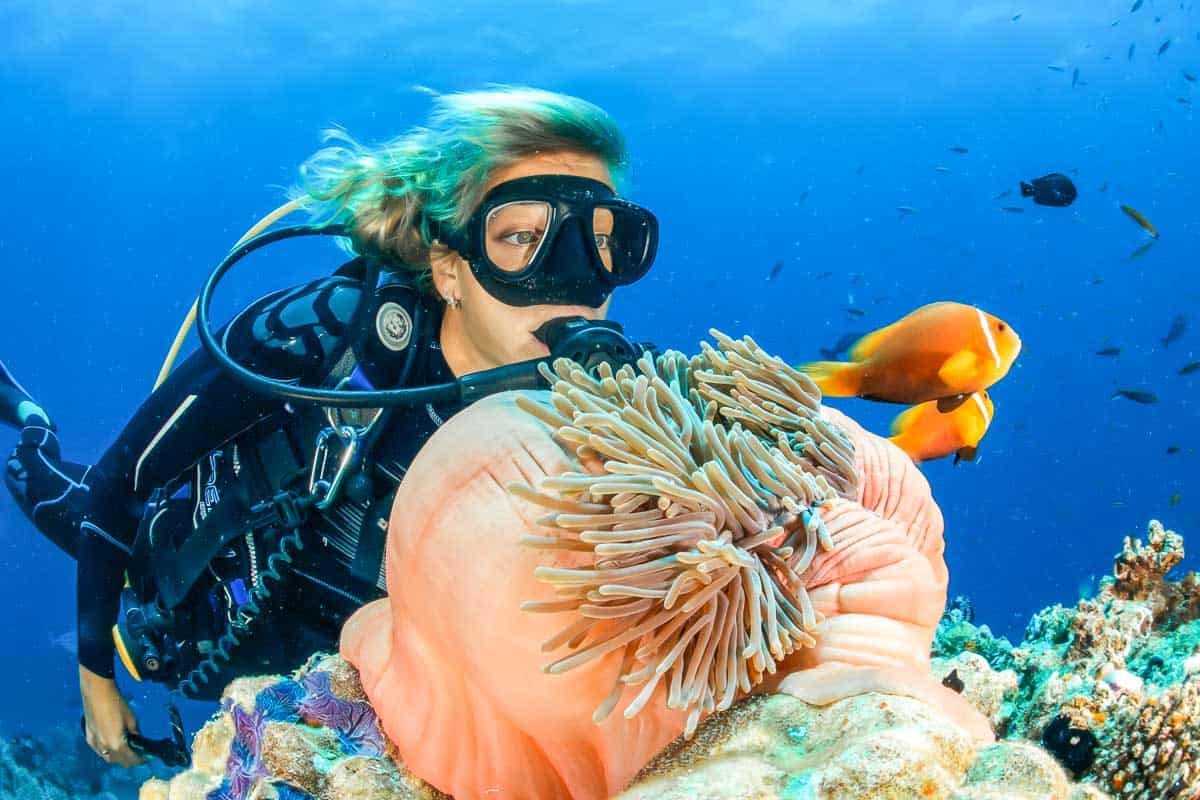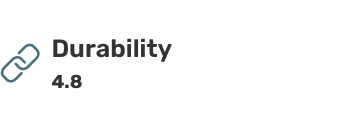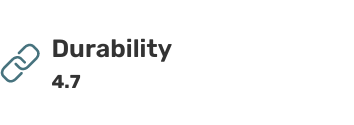Having your own scuba diving gear is great, but airline baggage limits can cause problems for traveling divers. Your BCD is the bulkiest piece of dive gear and you’re probably aware of how much space it takes up in your suitcase. Travel BCDs aim to solve this problem by making use of lightweight materials (think plastic instead of metal D rings). These best travel BCDs are designed to take up as little space as possible. Fast-drying materials are another bonus because they make your return trip easier. We’ve rounded up the ten best lightweight travel BCDs for you, and our Buyer’s Guide will help you decide which one is best for you.
ALL THE LIGHTWEIGHT TRAVEL BCD THAT WE TESTED
SCUBAPRO Go BCD
General Impression
ScubaPro provides yet another wholesome piece of equipment that’ll fit like a glove for diving beginners. With a lift capacity from 22 – 42 lbs, ScubaPro’s Go BCD offers divers a unique experience without having to worry about their BCD. The Go travel BCD features a traditional jacket design that’ll ensure comfort thanks to the padded straps that wrap around nicely.
Specifications
WEIGHT: 6.6 Pounds
STYLE: Jacket
WEIGHT SYSTEM: Integrated
MATERIALS: Polyurethane-covered Denier Nylon
PROS
- It comes with a travel bag
- Accessories can be stored inside the BCD
- Extras can be stored outside the BCD
CONS
- Not the cheapest option
ZEAGLE Scout BCD
General Impression
If you won’t settle for anything less than a comfortable travel BCD, then this compact piece of equipment courtesy of Zeagle is your go-to choice.
Zeagle’s Scout features a hose, an inflatable back part, and padded wraps that ensure a secure fit around the shoulders and waist. With a lined and comfy backplate, you can rest assured that you won’t feel your back getting poked into and leaving you twisting and turning all the time.
What makes the Scout quite the travel companion is its 20 lbs capacity and a rear-weight system. It’s standardly manufactured for a lift capacity of 24 lbs.
Specifications
WEIGHT: 2.2 pounds
STYLE: Back-inflated
WEIGHT SYSTEM: Integrated
MATERIALS: Reinforced Denier Nylon
PROS
- Accessories can be stored outside the BCD
- Easy rinsing
CONS
- No integrated pockets
SCUBAPRO Hydros Pro
General Impression
First off, unlike other travel BCDs that are traditionally made of nylon, this beaute is fashioned out of a distinguished material called monprene – durable, strong, quick-drying, and retaining very little water.
Back-inflated, with an alternate AIR2 source, and a lift capacity of 36 pounds, this diving piece of equipment has all the essentials.
Specifications
WEIGHT: 4 pounds
STYLE: Back-inflated
WEIGHT SYSTEM: Integrated
MATERIALS: Monprene
PROS
- Parts can be easily replaced
- Outstandingly quick-drying
- Very comfortable
- Many D-rings and annex points
CONS
- Quite expensive
- Pretty heavy
XDEEP NX Zen Deluxe BCD
General Impression
As a piece of single-tank diving equipment, XDeeep’s NX Zen Deluxe Travel BCD offers a choice between a large and a small backplate. Featuring aluminum construction, 2×10 lbs weight pockets, and a V-crotch strap, this travel BCD will offer an even more comfortable fit while underwater.
Intentionally made to be narrower, the NX Zen makes buoyancy control easier, which further reduces drag. Thanks to the smaller drag rate, gas consumption is improved, enhancing durability and safety while diving.
Specifications
WEIGHT: 6.6 pounds
STYLE: Back plate and wing
WEIGHT SYSTEM: Integrated
MATERIALS: Aluminum, Nylon
PROS
- Lightweight
- Durable
- Suitable for any diving environments
- Comfortable
- Parts are very easy to replace
- Comes in many color options
CONS
- A bit on the pricier side
ZEAGLE Express Tech BC
General Impression
The Zeagle Express Tech BCD is an ultra lightweight travel BCD that’s a great budget option, which is why it topped our best travel BCD review. It’s equipped with twin tank bands for peace of mind and features a rear bladder with extra padding for a comfortable fit. The integrated weight system can handle up to 20 pounds and there are dual rear-pull dump valves if you need to rid yourself of air. It’s easy to rinse the bladder after diving thanks to the Bx Inflator that can be attached to a standard garden hose. This scuba Zeagle travel BCD easily folds up to fit in your luggage, whether you’re traveling to the tropics or just across the country.
Specifications
WEIGHT: 5 pounds
STYLE: Back inflation
WEIGHT SYSTEM: Integrated
MATERIALS: 1000 Denier Cordura
PROS
- Ultra-lightweight
- Padded rear bladder
- Integrated weight system
- Folds up easily for transport
- Easy-to-rinse bladder
CONS
- Lack of emergency dump valve on shoulders
- Can’t attach weights to tank strap
HOLLIS Light Travel System
General Impression
The Hollis LTS is a deservedly popular piece of travel scuba gear, with a lift capacity of 30 pounds (despite being only 5 pounds in weight itself). The red and black coloration is appealing, as are the chest and hip D-rings for attaching all your accessories. Diving travel BCD reviews often mention that it’s incredibly comfortable to wear, even for long periods of use. This lightweight travel BCD is ideal for warm water diving by either beginners or experienced divers.
Specifications
WEIGHT: 5 pounds
STYLE: Back inflation
WEIGHT SYSTEM: Integrated
MATERIALS: 1000 Denier Cordura
PROS
- Incredibly lightweight
- Integrated weight system
- Rugged construction
- 30-pound lift capacity
- Very comfortable to wear
- Available in four sizes
CONS
- Tank band placement could be improved
- Difficult to use oral inflator hose
OCEANIC Biolite Travel Scuba Diving BC
General Impression
One of the best lightweight travel BCDs for beginner and intermediate divers is this Oceanic Biolite model. It boasts a streamlined, integrated weight system that can handle up to 14 pounds while the vest itself weighs in at just 5.5 pounds. The low profile backpack design means you can fold it in two when traveling and there are three different color choices available. The design is straightforward, comfortable and convenient, which is why it’s one of the best travel BCDs in 2023.
Specifications
WEIGHT: 5.5 pounds
STYLE: Back inflation
WEIGHT SYSTEM: Integrated
MATERIALS: 1000 Denier Cordura
PROS
- Incredibly lightweight
- Can be folded in half for travel
- Quick drop weight release system
- Streamlined design
- Three color options available
- Five size options available
CONS
- Only a single tank strap
- Difficult to tighten around the body
CRESSI Travelight BC
General Impression
One of the cheapest travel BCDs on the market, this comfortable Cressi model comes in two color options. Its design was inspired by the Cressi Flex Travel BCD, with a padded back and integrated weight system that can handle up to 30 pounds. In addition, there are suitably placed pockets where you can safely store accessories. It’s renowned for its ultra-fast inflation and deflation, as well as folding down into a compact and easily stow-able package for travel.
Specifications
WEIGHT: 6 pounds
STYLE: Back inflation
WEIGHT SYSTEM: Integrated
MATERIALS: 210 Denier nylon
PROS
- Folds down into a compact size for travel
- Soft padded back for comfort
- Fast inflation and deflation speeds
- Eight lightweight D rings
- Affordable travel BCD
CONS
- Integrated pockets sometimes pop-out
- Stitching is not durable
AQUA LUNG Zuma Travel BCD
General Impression
At just 4.4 pounds, this weight integrated travel BCD is one of the lightest on the market. But despite its weight, it doesn’t compromise on features, with pockets for essential accessories and four D-rings. The padded back offers plenty of lumbar support while it’s still easy enough to fit into a suitcase. It features Aqualung’s Surelock II integrated weight system for peace of mind that your weights won’t accidentally slip out. The adjustable chest strap also allows you to get a snug fit around your body.
Specifications
WEIGHT: 4.4 pounds
STYLE: Back inflation
WEIGHT SYSTEM: Integrated
MATERIALS: 420 Denier Cordura
PROS
- Ultra-lightweight
- Padded spine and lumbar support
- Adjustable chest strap
- Patented Aqualung integrated weight system
- Can fit into a suitcase
CONS
- Difficult for bigger bodies to don
- D-ring placements could be better
CRESSI Start Jacket Style BCD
General Impression
Ideal for Dive Centers where the jackets are often inflated to their maximum capacity. The size is clearly visible on the shoulder strap. The Denier Nylon Cordura is more resistant to erosion caused by long-term friction and extends the duration of the weldings, as it is harder than Nylon. The waist strap is independent of the air bladder. The strap can be tightened while the jacket is deflated without squeezing the diver’s stomach when the jacket is inflated. Inflator with double air filtration system; under the hose connection stem and around the valve. The inflator can easily be rinsed to remove sand and other debris. The backplate system is made of ultra-durable thermoplastic, truly small and compact for lightness. A rubber damper helps grip the tank, a second tank strap can be added. A nylon locator strap is included to ensure proper tank position every time. 3 exhaust valves for buoyancy adjustment in any position.
Specifications
WEIGHT: 5.7 pounds
STYLE: Back inflation
WEIGHT SYSTEM: Integrated
MATERIALS: 1000 Denier Cordura
PROS
- Incredibly lightweight
- Streamlined technology for easy buoyancy regulation
- Three-dump deflation system
- Optional quick-release pockets available
CONS
- Not suited for cold-water diving
- More expensive than other travel BCDs
BEST LIGHTWEIGHT TRAVEL BCD
Buyer's Guide
As with all diving equipment, the best travel BCDs will depend on the type of diving you do and your individual preferences. In this guide, we’ll explain the different types of buoyancy control devices available and what features to look for when purchasing lightweight travel BCDs.
Types of BCDs
When it comes to purchasing top-rated buoyancy compensators, there are a few options to select from:
Jacket travel BCDs are the most common style, with an air bladder that wraps around the torso and back. When inflated, it provides equal support around the diver’s body, making it easy to remain stable in various underwater positions. These are generally the best buoyancy compensator for beginner divers but they tend to be heavy and not ideal for travel.
Back-inflations travel BCDs have an air bladder positioned at the back of the diver. This gives you greater freedom to move your arms and helps you to maintain a horizontal position in the water. However, back inflation BCDs take some getting used to, as they will push you forward at the surface without the use of trim weights on the tank or rear.
Hybrid travel BCDs incorporate elements of both the jacket and back-inflation styles. The air bladder isn’t as bulky at the front as with traditional jacket BCDs but it also allows for a comfortable upright position at the surface.
Travel BCDs come in a variety of styles but share one common feature – they are lightweight and can fold down to a compact size. This is usually achieved by limiting their features to some degree, although technology innovations are enabling travel BCDs to be manufactured on par with their weightier counterparts.
Backplate and wing travel BCDs are customizable and popular with tech divers, as you can add individual components depending on your diving needs. You can design a system that caters to the dives you will be doing on a particular day, whether it’s deep diving, cave diving or wreck diving.
Lift capacity
The lift capacity of a travel BCD refers to the amount of negative weight it can float when fully inflated. This is most important if you’re carrying a lot of extra gear to counter the positive buoyancy of a thick wetsuit when diving in cold water conditions. If your BCD doesn’t have adequate lift capacity, you will have a hard time staying afloat when at the surface.
If you’re diving in mostly tropical waters with a shorty wetsuit, then 12 to 24 pounds in lift capacity is adequate. Recreational diving in a full wetsuit will require between 20 to 40 pounds while technical diving with lots of additional equipment and tanks may necessitate a BCD with between 40 and 80 pounds lift capacity.
Weight integration
Another important feature to look for in BCDs for traveling is weight integration. This allows you to put weights directly into specially designed pockets on the BCD, rather than wearing a weight belt. A weight integration system is favored by many divers as you can strategically place your weights to achieve better buoyancy.
If you’re buying a BCD with an integrated weight system, look for a quick-release mechanism. This enables you to rapidly ditch your weights in an emergency situation by simply pulling a tab. But check carefully how it works before your first dive so you know how to use it and don’t accidentally drop the weight pockets underwater.
D-rings, loops, and pockets
Most BCDs have D-rings, loops and/or pockets so you can attach dive tools and accessories. The number of attachment points you need will depend on the type of diving you’re doing and what you want to take with you. Perhaps you want to take a dive torch, knife and backup mask, as well as a surface marker and whistle. Look for D-rings made from stainless steel (which are the most durable), rather than plastic or aluminum.
Weight and size
One of the most important features to consider when buying a travel BCD is its weight and how compactly it folds up. Ideally, you want a light BCD that will be able to fit in your luggage, so you aren’t paying excess baggage fees with airlines. If you have to walk to and from dive sites, then a lightweight BCD is even more important. That being said, you don’t want to compromise on the features you really need, just for the sake of a pound or two.
Fit
Finding a good fit is essential when purchasing a new BCD. If you buy a size too big, the BCD will constantly rise up above your shoulders. If it’s too small, you may feel restricted in your movements and won’t be able to use the BCD when wearing a thicker wetsuit. If you are diving in both dry suits and thin wetsuits, then it’s important to buy a BCD that can accommodate both.
Women’s BCDs
While some BCDs will fit both men and women comfortably, others won’t. Most scuba diving manufacturers offer women’s designs, with a shorter torso and adjusted straps. If you’re not sure whether a buoyancy compensator will fit you and you’re purchasing online, check the travel BCD reviews to see what other users have to say.
BEST LIGHTWEIGHT TRAVEL BCD
FAQs
What does BCD stand for in scuba diving?
BCD stands for buoyancy control device, although they’re often referred to as buoyancy compensators. A BCD is worn during dives to ensure positive buoyancy at the surface and neutral buoyancy underwater. This is controlled by adjusting the amount of air that flows in and out of the BCD’s inflatable bladder, which is connected to the tank via a low-pressure hose.
BCDs come in various types (jacket, back-inflation, and hybrid) and with a range of features, which make them suitable for different diving needs. Mastering the control of a BCD to fine-tune your buoyancy is one of the trickiest parts of learning to dive and something that’s acquired through regular practice.
What is the best beginner BCD?
Most divers begin with a jacket-style BCD, which features an air bladder that wraps around the torso and back. It’s designed to provides equal support around the diver’s body so they can remain stable in different positions under the water. Jacket-style travel BCDs are the type that you’ll most commonly find in dive shops and dive schools around the world. However, they tend to be heavy and are not ideal for divers who travel frequently.
What is the best type of BCD?
The best travel scuba gear for you depends on your experience and the type of diving you will be doing. If you’re just starting out, then a jacket-style travel BCD will make it easier for you to remain stable underwater. Once you’ve mastered your buoyancy and have more experience, you may want to try using a back-inflation travel BCD, which positions the air bladder at the back. The advantage of these travel BCDs is that they help you maintain a horizontal position in the water and give you greater freedom to move your arms. Hybrid travel BCDs combine elements of both the jacket and back-inflation styles while allowing you to stay in a comfortable, upright position at the surface.
If you’re traveling frequently to dive, then you’ll probably want a lightweight and compact travel BCD. Most are back-inflation style and utilize lightweight materials and innovative designs to reduce their bulkiness. Technical divers may want to consider a backplate BCD that’s customizable to their diving needs.
What is the best jacket BCD for diving?
The best jacket BCD is the one that offers the features that meet your diving needs. Things to consider include the lift capacity of the travel BCD and whether it offers weight integration. If you are considering a travel BCD with an integrated weight system, look for a quick-release mechanism so you can easily ditch your weights in an emergency situation.
Other features to consider are the number of D-rings, loops or pockets available to stash your diving accessories, such as torches, knives and surface marker buoys. Women can look for specially designed women’s BCDs that offer a shorter torso and adjusted strap positions for a more comfortable fit. The weight of a BCD is another important feature. Rather than being a jacket style buoyancy compensator, the best light BCD models tend to be back inflation.
How to size a scuba BCD?
Sizing for travel BCDs is roughly parallel to your T-shirt size, so this is a good starting point. A BCD should fit snuggly, without being too tight, and come with adjustable straps so you can alter it if you’re wearing a thicker or thinner wetsuit. Before purchasing your travel BCD, consider the type of exposure protection you will be wearing (a lycra skin or 7-millimeter wetsuit), as this will affect the size of travel BCD you should buy.
When trying on a travel BCD, loosen all the straps and place it on over your T-shirt. Adjust the cummerbund so that it fits snuggly across your abdomen, with at least 2-3 inches overlapping. Connect the waist strap buckle so that it’s secure but not too tight, then connect the sternum buckle strap and tighten it so that the shoulder straps are well-positioned. Then tighten the shoulder straps, ensuring there are at least 1-2 inches of excess strap for adjustments. If there are big gaps around the shoulder area, try on a smaller size.
What does a BCD do in scuba diving?
A BCD is designed to help a diver achieve neutral buoyancy underwater and positive buoyancy when at the surface. They feature an inflatable air bladder that can be manually manipulated to allow air to flow in and out as needed. Air flowing in will cause the diver’s position to rise slightly while air being released will do the opposite. Mastering the control of your BCD and fine-tuning your buoyancy is something that takes practice. The amount of air you need in your BCD will change depending on the amount of air left in your tank, the weight you are carrying and the thickness of your wetsuit.
How to care for your BCD?
Like all scuba diving equipment, your buoyancy compensator will need to be cared for properly if you want it to have a long life. The exterior can be simply rinsed in freshwater, removing any saltwater residue or ocean debris. But it’s also important that you rinse the interior of the air bladder, as saltwater crystals can form over time and rupture it. The easiest way is to use a garden hose and flush freshwater into the bladder via the low-pressure oral inflator while holding down the deflate button.
REACH OUT
As always, we create our content with you, fellow adventurers, in mind. So, how’d we do? Did you find this informative? Did it help you make a decision? Did we miss anything? We’d love to hear from you below. Thanks for reading and we hope your next adventure is a great one!












































